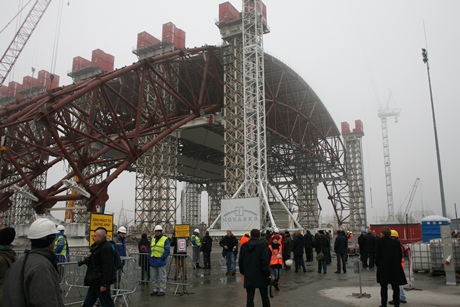Assembly of the giant structure that will protect the ruined Chernobyl unit 4 and enable its dismantling has reached a milestone with the raising of the first arch.
 |
| The first arch of the Chernobyl NCS has been raised off the ground (Image: WNN) |
Construction of the New Safe Confinement (NSC) structure was officially launched in April during a visit by Ukrainian President Viktor Yanukovych. This arched structure - some 108m high, 257m wide and 150m long - will be assembled on concrete rails and slid into place over the broken buildings of Chernobyl 4. Some 20,000 tonnes of steel will be used in the structure's construction, the first batch of which was delivered to site in March.
The NSC has now started to take shape with the first section of arched steel work being raised to an initial height of 22 metres on 24 November. The first cladding was installed on this section in October. This section, weighing some 5300 tonnes, will form part of the top of the arch. More sections will now be attached to extend the arch after subsequent lifting operations. After a second and third lifting operation, this initial section will be raised to a height of over 100 metres.
These first segments of the arch structure were pre-assembled on the ground in a construction area just some 300m from the damaged reactor. In order to reduce radiation exposure to construction workers, some 55,000 cubic metres of contaminated soil were removed from this area and a 90,000 square metre concrete work area was laid upon it.
The NSC will be assembled in two halves. Once the first half is completed, it will be pushed into a holding area in front of unit 4 while the sections of the second half are assembled. When this is complete, the two sections will be joined together. The completed structure will have some 86,000 square metres of cladding.
The NSC is being constructed in two stages. The initial stage involves assembly of the arched structure, while the second stage will involve installing infrastructure (such as cranes) for dismantling the shelter structures and the removal of fuel. Assembly of the NSC is expected to be completed by the end of 2014, while installation of systems will take place during 2014 and 2015.
Once this second stage is completed, the entire structure - weighing some 31,000 tonnes - will be pushed over unit 4 and part of its turbine hall using hydraulic jacks. This sliding operation - expected to take three days - is scheduled before the end of 2015. End walls will then be built to strengthen and seal the NSC, creating a means of confining dust and debris from the dismantlement of unit 4 while protecting it from harsh weather. However, the structure is not designed for radiation shielding: gamma radiation doses outside of the NSC will be about the same as they are now.
The NSC, which is being funded by the international community through donations to the European Bank for Reconstruction and Development (EBRD) is designed to last at least 100 years, by which time most of the decommissioning work on unit 4 should be completed. A contract for the design and construction of the NSC was signed in September 2007 with the Novarka consortium, formed by French construction companies Bouygues and Vinci.
EBRD president Suma Chakrabarti: "This is a very significant milestone, which is a tribute to the ongoing commitment of the international donor community, and an important step towards overcoming the legacy of the accident for the people of Ukraine, Belarus and all other countries affected by the Chernobyl catastrophe."
Researched and written
by World Nuclear News




_82983.jpg)
_34792.jpg)
_16403_79272.jpg)


_76087_55556.jpg)



